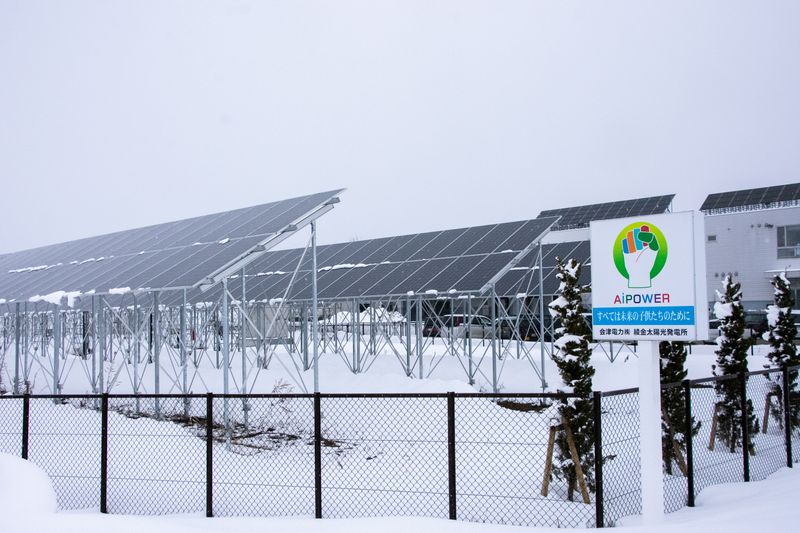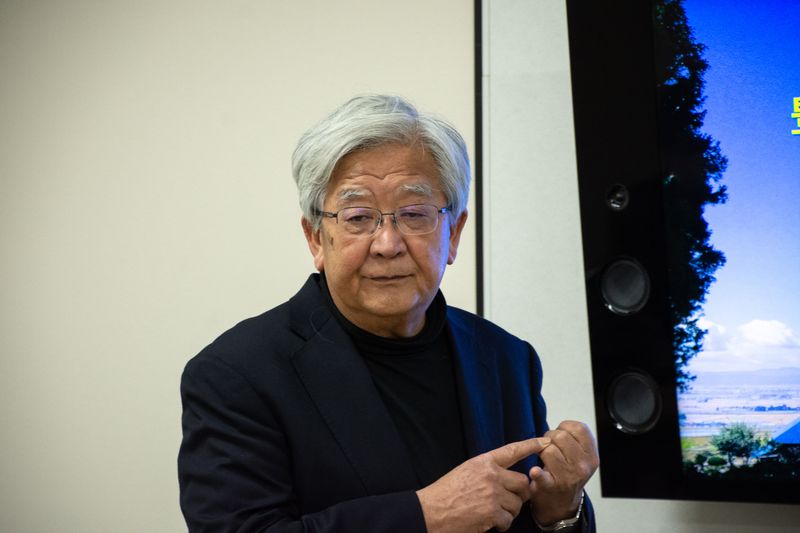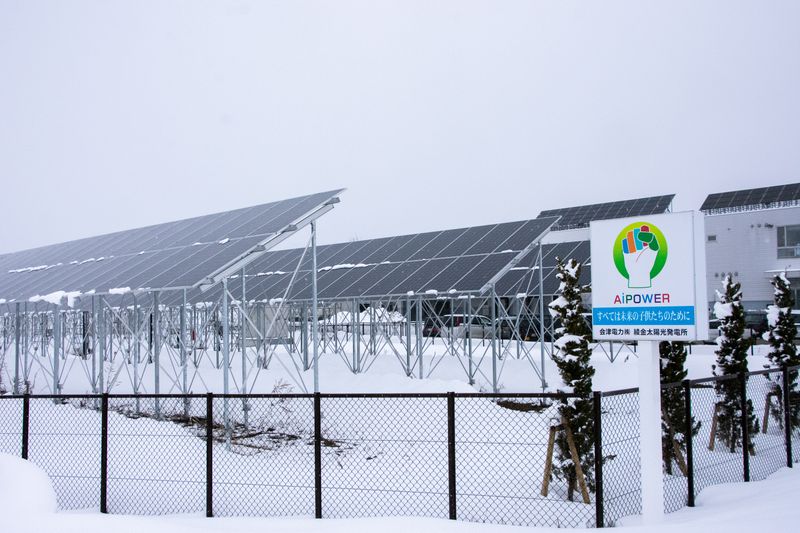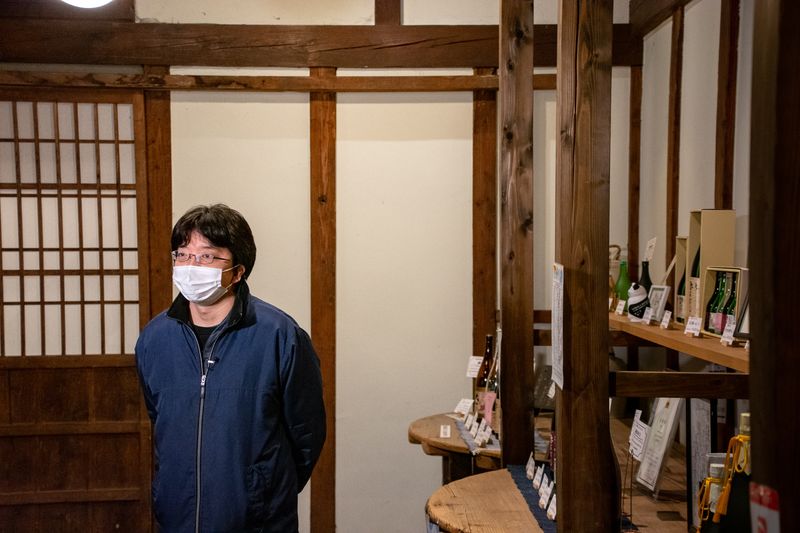Apr 1, 2021
Family of brewers pursues clean energy future for Fukushima region

Fuelled by nuclear disaster and a desire to protect local natural resources a family of brewers in Fukushima Prefecture is harnessing renewable energy to brew award-winning sake and power their home region toward freedom from big energy.
“In order to make sake we need water, rice, and the skills of the brewer, and energy,” explained Yauemon Sato, 9th generation brewer and current chairman of brewery Yamatogawa Shuzoten Ltd.
All of which came under threat around 10 years ago in the aftermath of the Fukushima Daiichi disaster.
“We feared the effect of radiation in this area. We didn’t know how the situation might develop and were afraid that we may no longer be able to live in this beautiful region. That we would be forced to give up this business we had been doing for 230 years,” Sato said during an interview in February in his hometown of Kitakata.

(Sato Yauemon, chairman of Aizu Electric Power Company, during an interview in his hometown of Kitakata, Fukushima Prefecture)
Located in the Aizu Basin in western Fukushima Prefecture, Kitakata is a landscape of traditional kura storehouses that are home to a number of sake breweries. Structurally, the kura that make up the Yamatogawa facility suffered little, if any, damage after the Great East Japan Earthquake on March 11, 2011. Sato and his team were even able to help distribute water from their Kitakata base to some of the affected cities including Koriyama, Fukushima, Iwaki, and Iitate.
That they were able to do so may be a reflection of a region which, according to Sato, is rich in natural resources, in particular the kind of clear water that makes for healthy rice production and thus, and with the right brewing techniques, award-winning sake.
“We grow our own rice from some 60 hectares of our land. We have easy access to water and we have our own brewing techniques. But the energy we had been using was in the form of electricity generated by the nuclear power plant, as well as from fossil fuels,” Sato explained.
“To an extent we have to take some responsibility for depending on this dangerous nuclear power but we were told repeatedly that energy generated from nuclear power is clean and safe. That there would be no such incidents at the nuclear plants.”
“In front of our own eyes though, we saw how easily such a terrible incident could occur and how dangerous this kind of energy is. It made us question our reliance on it.”
Sato and others found the answer to their question in the potential for a green, renewable energy supply using the natural resources of the Aizu region which led to the founding of Aizu Electric Power Company, in August 2013, of which Sato is now chairman.
With an objective of spreading awareness about alternative energy and developing alternative energy generation methods for the Aizu community, Aizu Electric Power Company received early investment from eight of the region's 17 municipalities.
In terms of energy generation the company was quick to explore solar power despite the challenges of doing so in a region that receives heavy snowfall.

(Aizu Electric Power Company solar power plant in the Aizu region. The company’s solar panels are typically fitted 2.5 m above the ground to mitigate the build up of snow.)
Aizu Electric Power Company, together with its subsidiaries, currently operates 87 solar power plants and one small hydroelectric plant with a combined energy output capability of 6,089 kW.
The company’s plants are distributed throughout the Aizu region and central Fukushima Prefecture with each constructed on a smaller scale, designed to serve only the area that needs it in order to mitigate the risk of energy shortage should disaster strike, a prospect the wider region has become all-too-familiar with.
“Electric power sources should be set up in the regions where the energy is needed,” Sato said.
“In Japan so many people have become concentrated in Tokyo and other large cities. It’s a situation that carries a lot of risk, be it from things like the coronavirus or earthquakes. These levels of concentration aren’t good. It’s the same with energy generation.”
Response to the efforts of Aizu Electric Power Company from local residents has been positive although with some 100,000 households in the region plenty of encouragement is still needed in order for people to switch their supplier, according to Sato. There appears even more of a challenge facing the company if its goal to have the entire region’s energy needs -- 350,000 kW, according to Sato -- fully supplied using local renewable sources, is to be met.
The colors of the company logo hint at other solutions being explored -- brown for “biomass,” light blue for “wind,” among them. The clenched-fist design, however, appears to hint at a different kind of energy fueling Sato.
According to the brewer, large energy companies operating hydroelectric power plants in Aizu are using water from the region’s Lake Inawashiro and nearby rivers to generate electricity for use outside of the region. With the companies’ use of “Aizu water” generating combined annual sales roughly equivalent to the GDP of the Aizu region itself (over 600 billion yen) Sato feels local communities are being denied the chance to generate the energy they need to be self-sufficient.
“We want to take back what has been stolen from us. It’s our water. It belongs to this region. If we do this, then we could be self-sufficient in terms of energy in one or two years.” Without this resource Sato speculates it could take 20 years. By that time the Japanese government could be well on the way to realizing an energy-related goal of its own -- carbon neutrality by 2050, as declared by Prime Minister Yoshihide Suga in October last year.
Government strategy for reaching carbon neutrality looks set to include the restarting of nuclear power plants as outlined in the Ministry of Economy, Trade and Industry’s “Green Growth Strategy Through Achieving Carbon Neutrality.”
Industry leaders have also highlighted the need for an increase in the use of nuclear power in order to achieve carbon neutrality, citing Japan’s lack of natural energy resources.
En route to this neutrality around 20 to 22 percent of total generated electricity is targeted to come from nuclear power in Japan’s desired energy mix for 2030. In view of this target, Japan Atomic Industrial Forum Chairman Takashi Imai, in a New Year’s greeting, described the number of nuclear units currently in operation as “woefully short.”
“To achieve carbon neutrality and improve energy self-sufficiency, Japan will have to restart the remaining idle nuclear reactors as soon as possible,” he said in his greeting.
Sato, however, was unreserved in his thoughts regarding government thinking on nuclear power, which he described as “total nonsense.”
“Whether there are further incidents or not over the next, say, 30 or 40 years, the decommissioning of these plants will cost a great deal of money. In the case of this disaster we don’t know how much it’s going to cost. It remains a really dangerous situation,” he said.
“This country needs to stop using nuclear power. We can do it all with green energy.”
Sato appears to almost delight in challenging big energy and the policies of the central government. His sometimes colorful, almost mischievous, criticism of their conduct though, seems rooted in a much more humble concern for the future of places people call home, including his own.
“Kitakata is my hometown. Our brewery has been passed on through my ancestors for 230 years. We are surrounded by great nature, we have access to pure water and local rice. These things combined with our own production techniques and the cold winters come together in the brewing of sake. In order to be able to pass this tradition on to younger generations I want to look after my hometown with great care.”
The next generation is already in place at the Yamatogawa brewery with Sato’s son, Masakazu, having assumed the position of managing director of the company. The younger brewer continues Yamatogawa's commitment to using local resources which has helped produce award-winning sake brands.
Since the launch of agricultural corporation Yamatogawa Farm in 2007, the brewery has been using its own home-grown rice for sake production while organic by-products from the production process are used to make ecological fertilizers.
Much of the energy powering the brewery is sourced locally, too. Speaking at Yamatogawa’s on-site store and tasting corner, Masakazu estimated that around 80 percent of the energy used by the brewery is supplied by the solar power of Aizu Electric Power Company.
“We’ve established our identity in the market by promoting the use of resources that are local to us, even before we started using renewable energy. Using local renewable energy strengthens this identity further,” said Masakazu
The events of 10 years seem only to have further fueled this identity.
“As someone who witnessed what happened and the aftermath of that, I think it would be a mistake to continue relying on nuclear energy,” he said.
“The Aizu region has so many environmental resources. Using local water, rice, as well as energy, it’s the right way to go.”

(Masakazu Sato in the tasting room of brewery Yamatogawa Shuzoten)
The sake brewers of the Aizu region might be said to be familiar with pursuing the right way during challenging times, for the production of their sake as well as for the strength of the region as a whole. Yamatogawa Shuzoten itself was established in 1790, a time when the sake industry, with the support of the ruling Aizu clan samurai, was a key source of fuel for the local economy following the Great Tenmei Famine.
Sake produced by the region's breweries has since helped to establish Fukushima Prefecture as arguably the most important sake-producing region in the country.

(Sake tasting, Yamatogawa Shuzoten)
Related articles on City-Cost
10th anniv. exhibition unearths symbols of hope from 2011 disaster heritage
Interview with a geigi: Higashiyama Onsen, Aizuwakamatsu



0 Comments